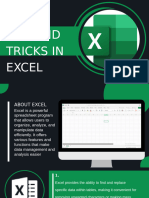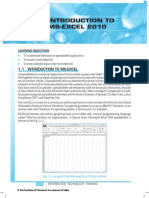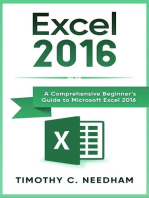005
005
Uploaded by
blessingfabiyi5309Copyright:
Available Formats
005
005
Uploaded by
blessingfabiyi5309Original Description:
Copyright
Available Formats
Share this document
Did you find this document useful?
Is this content inappropriate?
Copyright:
Available Formats
005
005
Uploaded by
blessingfabiyi5309Copyright:
Available Formats
MS-EXCEL
MS-EXCEL is a part Microsoft Office suite software. It is an electronic spreadsheet with numerous
rows and columns, used for organizing data, graphically represent data(s), and performing different
calculations. It consists of 1048576 rows and 16383 columns, a row and column together make a cell.
Each cell has an address defined by column name and row number example A1, D2, e.t.c. this is also
known as a cell reference.
Cell references: the address or name of a cell or a range of cells is known as Cell reference. It helps
the software to identify the cell from where the date/value is to be used in the formula.
The Ribbon in MS-Excel is the topmost row of tabs that provide the user with different facilities/
functionalities. These tabs are:
1. Home Tab: it provides the basic facilities like changing the font, size of text, editing the cells in
the spreadsheet, autosum, e.t.c
2. Insert Tab: it provides the facilities like inserting tables, pivot tables, images, clip art, charts,
links, e.t.c
3. Page Layout: it provides all the facilities related to the spreadsheet-like margins, orientation,
height, width, background e.t.c. The worksheet appearance will be the same in the hard copy as
well.
4. Formulas: It is a package of different in-built formulas/functions which can be used by user just
by selecting the cell or range of cells for values.
5. Data: The Data Tab helps to perform different operations on a vast set of data like analysis
through what-if analysis tools and many other data analysis tools, removing duplicate data,
transpose the row and column, e.t.c. It also helps to access data(s) from different sources as
well, such as from MS-Access, from web, etc.
6. Review: This tab provides the facility of thesaurus, checking spellings, translating the text, and
helps to protect and share the worksheet and workbook.
7. View: It contains the commands to manage the view of the workbook, show/hide ruler,
gridlines, e.t.c., freezing panes, and adding macros.
Creating a new spreadsheet:
In Excel 3 sheets are already opened by default, how to add a new sheet:
In the lowermost pane in Excel, you can find a button.
Click on that button to add a new sheet.
MS-Excel shortcuts:
1. Ctrl+N: To open a new workbook.
2. Ctrl+O: To open a saved workbook.
3. Ctrl+S: To save a workbook.
4. Ctrl+C: To copy the selected cells.
5. Ctrl+V: To paste the copied cells.
6. Ctrl+X: To cut the selected cells.
7. Ctrl+W: To close the workbook.
8. Delete: To remove all the contents from the cell.
9. Ctrl+P: To print the workbook.
10. Ctrl+Z: To undo.
You might also like
- Uganda Computer Studies Teaching Syllabus For Secondary Schools91% (81)Uganda Computer Studies Teaching Syllabus For Secondary Schools36 pages
- Sentimental Analysis: Software Requirements Specification100% (2)Sentimental Analysis: Software Requirements Specification9 pages
- Using Microsoft Excel For Data Processing: Practical WorkNo ratings yetUsing Microsoft Excel For Data Processing: Practical Work14 pages
- Abdulbasit H. Mhdi Assistant Lecturer Chemical Engineering/ Tikrit UniversityNo ratings yetAbdulbasit H. Mhdi Assistant Lecturer Chemical Engineering/ Tikrit University14 pages
- Abdulbasit H. Mhdi Assistant Lecturer Chemical Engineering/ Tikrit UniversityNo ratings yetAbdulbasit H. Mhdi Assistant Lecturer Chemical Engineering/ Tikrit University17 pages
- UNIT-3: 1. What Do You Mean by Cell in Ms-Excel?No ratings yetUNIT-3: 1. What Do You Mean by Cell in Ms-Excel?22 pages
- Spreadsheet: Rows Columns Numerical Software Formulas Cells Microsoft ExcelNo ratings yetSpreadsheet: Rows Columns Numerical Software Formulas Cells Microsoft Excel3 pages
- Microsoft Excel: Session 1 - Beginners Level100% (1)Microsoft Excel: Session 1 - Beginners Level105 pages
- Excel 2016: A Comprehensive Beginner’s Guide to Microsoft Excel 2016From EverandExcel 2016: A Comprehensive Beginner’s Guide to Microsoft Excel 20163.5/5 (3)
- Ppu 3 Application Notes Genset Control and Protection With Safety System 4189340621 UkNo ratings yetPpu 3 Application Notes Genset Control and Protection With Safety System 4189340621 Uk29 pages
- AN - 3352 How To Use SAMA5D2 IRQs Under Linux 00003352a PDFNo ratings yetAN - 3352 How To Use SAMA5D2 IRQs Under Linux 00003352a PDF13 pages
- 10 Best FREE Screenwriting Software Options For Writers in 2021No ratings yet10 Best FREE Screenwriting Software Options For Writers in 20211 page
- Paramount Reasoning Book in Hindi PDF Free Download (For More Book - WWW - Nitin-Gupta - Com)No ratings yetParamount Reasoning Book in Hindi PDF Free Download (For More Book - WWW - Nitin-Gupta - Com)207 pages
- Empowerment Technology 11 Quarter 1 Week 6: CompetencyNo ratings yetEmpowerment Technology 11 Quarter 1 Week 6: Competency9 pages
- Difference Between AX-2009 To Ax-2012: Anil Kumar Chowdary Minds2Mentor Technology PVT LTD 2/11/2012No ratings yetDifference Between AX-2009 To Ax-2012: Anil Kumar Chowdary Minds2Mentor Technology PVT LTD 2/11/20125 pages
- Web Application Performance Analysis of ECommerce Sites in Bangladesh - An Empirical StudyNo ratings yetWeb Application Performance Analysis of ECommerce Sites in Bangladesh - An Empirical Study8 pages
- Dokumen - Tips Cucerirea Unui Libertin Sarah Maclean50% (2)Dokumen - Tips Cucerirea Unui Libertin Sarah Maclean367 pages
- TA030 Preliminary Conceptual ArchitectureNo ratings yetTA030 Preliminary Conceptual Architecture16 pages
- Morandi Color Work Report PowerPoint TemplatesNo ratings yetMorandi Color Work Report PowerPoint Templates25 pages

























































































